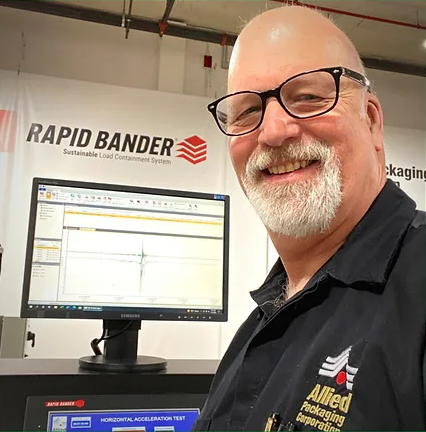Ask Steve
January 23, 2024
Question from Gavin: I was told by a supplier that the percent you can stretch film increases with thickness and the term ultimate strength was used. What does that mean and is it true that thick films can be stretched more?
Hi Gavin, thanks for the question, it is a subject that is widely misunderstood. Let me begin by defining the functional role of stretch film, because we should never lose sight of that. Motion of product on the pallet during transportation is at the root of most all load failures. Stop the movement, stop the load failures. When forces act upon the load as it travels from point A to B, the components of the load are put in motion. The stretch wrap must provide an equal and opposite force to prevent that movement.
If the applied force stretches the film further, more movement of the product is allowed. The more the product moves, the more inertia it has, requiring even greater containment force from the stretch film to prevent eventual failure. So, as we discuss film thickness and ultimate strength, we must assess what role they play in eliminating the “secondary stretch” of the film under load.
Now that we have some context, we can discuss film thickness. Thicker films can be stretched further, while to some extent that statement is true, it is misleading. In reality, the quality of the film and the resin blend determine how far a film can stretch. As a film is stretched it not only becomes longer, but it also becomes thinner. Slight imperfections in the film, such as gels, that would not normally be an issue, will become a failure point in thinner films. The resin blend used to produce the film also plays a role in how far it can be stretched because it controls the film’s elastic properties (modulus of elasticity). You can manufacture a thin film that can be stretched to over 450%. I have tested a film like that in our lab. While it had phenomenal elasticity, it required very little force to stretch. So, measuring its performance against the stretch film’s primary purpose, well, I certainly would not count on it to contain a load.
And that is a great segue into the ultimate strength topic. Ultimate Strength is the maximum force required to stretch the film over a distance. The stretch force increases and decreases over the distance until the film is stretched enough that it fails, or breaks. The measured force is then plotted to form a force-over-distance curve. Resin blend drives the shape of that curve more than thickness. The objective, for optimal load containment, is to stretch the film far enough on the load to reach its ultimate strength range. That will minimize secondary stretch, and from what we have just learned, we know how important that is. Film manufacturers will be more than willing to show the ultimate strength of their film, so should you pick the one with the highest ultimate strength? Sounds like a simple choice, but let’s put our feet back on the ground as we explore what happens in the “real world”.
We have developed a protocol to perform a “real world” test of stretch film performance in our lab, and using that, we characterized the performance of well over a hundred different films, from the lowest level of commodity films to the highest level of premium performance films. And in doing so, we have learned a great deal about film performance. Elasticity is critical in stretch wrap performance, but so is puncture resistance and tear propagation. As you stretch film to its ultimate strength, depending on the resin blend, it becomes stiff and/or brittle. This means that a sharp corner on a pallet, tier sheet, or even the product itself, can easily puncture the web, then once punctured, and under tension, the entire web will break. Our “real world” test protocol introduces puncture and tear as the film is stretched to varying degrees in addition to measuring strength.
The bottom line is that Ultimate Strength doesn’t mean much if you can’t stretch the film enough to maximize load containment because the web breaks as you wrap a pallet.
It is a balancing act between optimal strength, puncture, and tear resistance, and any way you go, it’s a compromise.
We understand the material science of stretch film, and therefore, understand its limitations. By incorporating a little physics, we have solved the issue with film breaks at higher levels of stretch (enough to reach ultimate strength). Our Rapid Bander technology uses two rolls of stretch film, one full web and one with bands. The combined thickness of two rolls of our Rapid Film is about the same as most single web conventional stretch films. The bands pass through rollers, which mechanically roll the edges, forming filaments. Both the banded and full webs join prior to entering the pre-stretch carriage of the wrapping machine where they are “laminated” together forming a single web with reinforcement filaments. The introduction of the filaments completely changes the dynamics of the film’s performance, allowing us to stretch it much further than conventional single web films. Not only do we achieve maximum force to load, but we have also taken virtually all the stretch out of the film, eliminating secondary stretch. If a sharp corner punctures the film, the resulting hole will expand to a filament and stop, preventing a web break. The reinforcement filaments give us exponentially greater performance than we could achieve by just using a thicker film.
No opinions or hype, it’s all about science!
I hope that helps you make a more informed evaluation of stretch film performance claims.
Thanks for asking!








